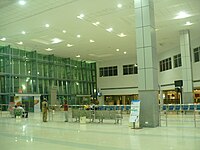
Photo from wikipedia
Abstract This paper examines the challenges associated with provision of effective transport services to the ‘mobility poor’ and identifies potential methods to overcome these challenges. “Prioritised area” types representing a… Click to show full abstract
Abstract This paper examines the challenges associated with provision of effective transport services to the ‘mobility poor’ and identifies potential methods to overcome these challenges. “Prioritised area” types representing a mix of geographies and population types, in addition to the multi-dimensional influences of mobility access, equity, and provision are identified, based upon the literature reviewed and information from transport providers, authorities and agencies. Supply side considerations are reviewed before turning to the potential ways for mitigating identified gaps in the requirements of prioritised areas, with particular reference to new models of transport service provision, technological solutions, and various modal and multi-modal solutions. The findings show that more flexible and integrated public transport solutions are being explored by cities, regions and service providers to address the constraints of more conventional models. Flexibility in such services is in the form of geographic, temporal, or vehicle flexibility. These are complemented by the opinion of experts as to the way forward for providing more tailored services for vulnerable users. Despite challenges, the paper identifies some promising service options for travellers in both rural and urban environments; however, any successful service must be underpinned by a robust, multi-modal transport network in order for that promise to be realised.
Journal Title: Research in Transportation Economics
Year Published: 2020
Link to full text (if available)
Share on Social Media: Sign Up to like & get
recommendations!